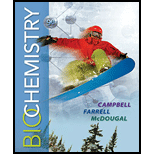
Concept explainers
MATHEMATICAL Which is more favorable energetically, the oxidation of succinate to fumarate by
Interpretation:
The reason for the oxidation of succinate to fumarate using
Concept introduction:
Oxidation is the addition of an electronegative element or the removal of an electropositive element in a chemical reaction.
Reduction is the addition of an electropositive element or the removal of an electronegative element in a chemical reaction
The chemical reaction in which oxidation and reduction take place simultaneously is called a redox reaction.
Cytochromes are the types of proteins that consists of iron as the heme group.
The
The
Answer to Problem 13RE
Solution:
The oxidation of succinate to fumarate using
Explanation of Solution
The half reactions that are paired during the redox reaction are shown below, along with their standard reduction potentials:
As the above aim reaction will get by subtracting
Hence, the overall voltage of the given biological reaction will be calculated.
As the above aim reaction will get by subtracting
Hence, the overall voltage of the given biological reaction will be calculated.
The value of the standard reduction potential in each case is negative. Thus, the oxidation of succinate to fumarate using
The oxidation of succinate to fumarate using
Want to see more full solutions like this?
Chapter 20 Solutions
Biochemistry
- REFLECT AND APPLY A model is proposed to explain the reaction catalyzed by an enzyme. Experimentally obtained rate data fit the model to within experimental error. Do these findings prove the model?arrow_forwardREFLECT AND APPLLY Show how the estimate of 33% efficiency of energy use in anaerobic glycolysis is derived.arrow_forwardREFLECT AND APPLY The malate-aspartate shuttle yields about 2.5 moles of ATP for each mole of cytosolic NADH. Why does nature use the glycerol-phosphate shuttle, which yields only about 1.5 moles of ATP?arrow_forward
- MATHEMATICAL For the following aspartase reaction (see Question 28) in the presence of the inhibitor hydroxymethylaspartate, determine KM and whether the inhibition is competitive or noncompetitive. [s](molarity)V,noInhibitor(arbitraryunits)V,InhibitorPresent(samearbitraryunits)110451041.5103510311.00.0260.0920.1360.1659.520.0100.0400.0860.1427.60arrow_forwardREFLECT AND APPLY Would you expect the production of sugars by plants in photosynthesis to be an exergonic or endergonic process? Give the reason for your answer.arrow_forwardREFLECT AND APPLY Explain how the pentose phosphate path- way can respond to a cells need for ATP, NADPH, and ribose-5- phosphate.arrow_forward
- REFLECT AND APPLY Why does the degradation of palmitic acid (see Question 12) to eight molecules of acetyl-CoA require seven, rather than eight, rounds of the -oxidation process?arrow_forwardREFLECT AND APPLY Noncompetitive inhibition is a limiting case in which the effect of binding inhibitor has no effect on the affinity for the substrate and vice versa. Suggest what a LineweaverBurk plot would look like for an inhibitor that had a reaction scheme similar to that on page 159 (noncompetitive inhibition reaction), but where binding inhibitor lowered the affinity of EI for the substrate.arrow_forwardREFLECT AND APPLY Suggest a reason why a different reducing agent (NADPH) is used in anabolic reactions rather than NADH, which plays a role in catabolic ones.arrow_forward
- REFLECT AND APPLY Would nature rely on the same enzyme to catalyze a reaction either way (forward or backward) if the DG were 0.8kcalmol1? If it were 5.3kcalmol1?arrow_forwardREFLECT AND APPLY Would you expect an irreversible inhibitor of an enzyme to be bound by covalent or by non-covalent interactions? Why?arrow_forwardREFLECT AND APPLY In the mitochondrion is a short-chain carnitine acyltransferase that can take acetyl groups from acetyl-CoA and transfer them to carnitine. How might this be related to lipid biosynthesis?arrow_forward
 BiochemistryBiochemistryISBN:9781305961135Author:Mary K. Campbell, Shawn O. Farrell, Owen M. McDougalPublisher:Cengage Learning
BiochemistryBiochemistryISBN:9781305961135Author:Mary K. Campbell, Shawn O. Farrell, Owen M. McDougalPublisher:Cengage Learning
